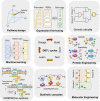Applications of synthetic biology in medical and pharmaceutical fields
- PMID: 37169742
- PMCID: PMC10173249
- DOI: 10.1038/s41392-023-01440-5
Applications of synthetic biology in medical and pharmaceutical fields
Abstract
Synthetic biology aims to design or assemble existing bioparts or bio-components for useful bioproperties. During the past decades, progresses have been made to build delicate biocircuits, standardized biological building blocks and to develop various genomic/metabolic engineering tools and approaches. Medical and pharmaceutical demands have also pushed the development of synthetic biology, including integration of heterologous pathways into designer cells to efficiently produce medical agents, enhanced yields of natural products in cell growth media to equal or higher than that of the extracts from plants or fungi, constructions of novel genetic circuits for tumor targeting, controllable releases of therapeutic agents in response to specific biomarkers to fight diseases such as diabetes and cancers. Besides, new strategies are developed to treat complex immune diseases, infectious diseases and metabolic disorders that are hard to cure via traditional approaches. In general, synthetic biology brings new capabilities to medical and pharmaceutical researches. This review summarizes the timeline of synthetic biology developments, the past and present of synthetic biology for microbial productions of pharmaceutics, engineered cells equipped with synthetic DNA circuits for diagnosis and therapies, live and auto-assemblied biomaterials for medical treatments, cell-free synthetic biology in medical and pharmaceutical fields, and DNA engineering approaches with potentials for biomedical applications.
© 2023. The Author(s).
Conflict of interest statement
The authors declare no competing interests.
Figures







References
-
- Le Duc, S. (eds) The Mechanism of Life (Rebman Company, 1914).
Publication types
MeSH terms
Substances
LinkOut - more resources
Full Text Sources
Medical
Miscellaneous

